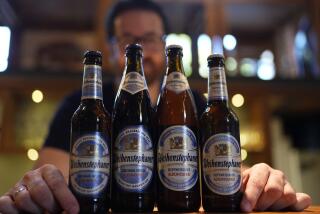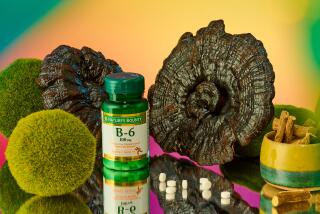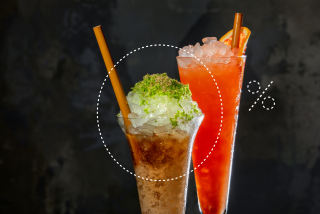New Ads Rekindle Controversy Over Non-Alcohol Beers
A dispute is brewing over the advertising of non-alcoholic beers, such as those now being introduced by the nation’s two largest brewers.
Both No. 1 brewer Anheuser-Busch Inc. and No. 2 Miller Brewing Co. are opening the money spigots to mount national advertising campaigns for their new non-alcoholic beers, hoping to tap a movement away from alcohol.
But some activists who have championed sobriety are turning on those very brews, calling for advertising warnings and accusing the brewers of misleading the public.
The dispute is a small part of a growing outcry to regulate alcohol advertising in general--a battle that brewers thought they had laid to rest years ago but that surfaced again last month when Transportation Secretary Samuel K. Skinner and Health and Human Services Secretary Louis W. Sullivan both called for increased regulation of alcohol advertising on television and radio.
The move toward sobriety is one of the reasons why Anheuser-Busch of St. Louis will roll out barrels of its non-alcoholic O’Doul’s malt beverage nationally on Monday and will spend an estimated $10 million to $12 million on national television, radio and print advertising. The ads, to be created by D’Arcy Masius Benton & Bowles in St. Louis, will carry the theme line, “O’Doul’s for Every O’Ccasion.”
Similarly, Miller of Milwaukee introduced its Sharp’s non-alcoholic brew on Dec. 11 with a national ad campaign that broke a week later, said Susan Henderson, a Miller spokeswoman. The estimated $8-million to $10-million campaign carries the theme line “Keep Your Edge” and is being handled by Frankenberry, Laughlin & Constable, a Milwaukee agency.
Both companies say they are targeting their mainstream beer-drinking customers: men 24 to 35 who are seeking a non-alcoholic alternative during business lunches and other occasions.
But a dispute has emerged over advertising plans, based on the legal definition of “non-alcoholic.” Federal regulations allow calling a beer non-alcoholic if it contains less than 0.5% alcohol by volume and require them to be so labeled.
Critics of the new brews, including the National Council on Alcoholism, argue that they still contain enough alcohol to pose a health risk and should be advertised with appropriate warnings, even though federal and state regulations require no such caveats.
“We want the labeling included in the ads, whether they’re on radio or on television, as is required on the container,” said Ray Chavira, a local anti-alcohol activist and member of the private nonprofit Los Angeles County Alcohol Policy Commission. “No amount of alcohol is a safe amount, especially for pregnant women, recovering alcoholics, minors and those persons prohibited by the court from (using alcohol) as a condition of their probation,” he argued. “Others may have allergic reactions to any amount of alcohol.”
Chavira has asked local television and radio stations to add titles or a live announcer’s warning to previously taped commercials for Firestone & Fletcher non-alcoholic brew, which is marketed as a “spacer” between beers containing more alcohol.
After Chavira complained, KNBC-TV Channel 4 agreed to add a superimposed title saying that the beverage contains less than 0.5% alcohol.
In fact, the station’s parent network, NBC, has a policy of adding such a title to ads for non-alcoholic beverages, and KNBC made a mistake in running the ad without one, said Richard P. Gitter, vice president for advertising standards at the NBC network in New York.
“It was an inadvertent omission,” he said. “We always thought it was a good idea to do it. . . . It’s virtually a trace amount of alcohol. . . . But with an abundance of caution and because of the nature of the product, we think it’s appropriate to mention that it has some alcohol.” He added that similar titles would be added to any ads for O’Doul’s or Sharp’s.
Others have left the ads alone. “The concern Ray brings up may be important . . . but we are reviewing this situation, and we have reached no conclusion because there’s no obligation on our part at present to put tags on these spots,” said Christopher Claus, vice president and general manager of KFWB-AM radio.
For their part, brewers have no plans to alter their advertising, arguing that such warnings are unnecessary.
The amount of alcohol contained in the new brews is comparable to that in some fruit juices and soft drinks, said Scott Anderson, a spokesman for Anheuser-Busch. “It’s called a non-alcoholic brew, and the alcohol content is mandated on the label and is prominently displayed on the label,” he added. As for a health risk, he said, “There is none.”
There is some evidence to support his conclusion.
A study prepared for the Federal Trade Commission’s division of advertising practices in 1985 and 1986 looked at the physical and psychological effects of non-alcoholic beverages--containing less than 0.5% of alcohol--on a variety of people, including recovering alcoholics and pregnant women. The study also examined whether non-alcoholic beverages increased the risk of cancer, cirrhosis, heart ailments and other diseases.
“In no instance did I find evidence that there would be a substantial risk of a physical sort,” said James M. Schaefer, director of the office of alcohol and other drug abuse programming at the University of Minnesota and author of the study.
He added: “The only risk area that I think could be debated is the issue of hypersensitivity” by people who are either allergic to alcohol or are taking the drug disulfiram, or Antabuse, which causes adverse physical reactions and is used to treat alcoholics.
In those cases, he said, a person “could detect some mild discomfort from consumption of even a single non-alcoholic drink product. But that would only occur from extreme reactivity and would not be very common.”
Aside from the physical risks, however, Schaefer said there might be a psychological risk for recovering alcoholics.
“A person who has had problems such as chemical dependency or alcoholism who then makes a decision to drink a de-alcoholized product that looks, smells and tastes just like the real thing, but doesn’t have the alcohol in it, puts himself or herself at risk. . . . It is the beginning step,” he said.
Critics of the non-alcoholic beverages have one other fear: that beer companies, despite their claims to the contrary, are marketing non-alcoholic brews as “training beers” for high school and college students too young to drink alcoholic beverages legally. Because they are considered non-alcoholic, the brews may be purchased legally by anyone.
“We have serious concerns that these products, either by design or actuality, may cause serious confusion among the young, and that they may in fact represent a seductive introductory vehicle to get the young to begin using a form of beer,” said Hamilton Beazley, president of the National Council on Alcoholism.
The beer companies vehemently deny that they are looking to win over young people. “We are not marketing to teen-agers,” Anderson said. “We feel this product is best suited for adults, and that they are the people who will buy it.”
In any case, some observers doubt that young people will even want to drink the stuff. “What kid in his right mind would drink a non-alcoholic beer?” Schaefer asked. “They’re going to try to sneak the real thing. And anything in a can is training of some kind, so I don’t buy that argument.”
Actually, analysts wonder if anyone will want to drink the stuff. Non-alcoholic beers account for less than 0.3% of the beer market now, or just 600,000 to 650,000 barrels per year in the United States, according to Beer Marketer’s Insights, an industry newsletter. A barrel contains 31 gallons.
Tom Pirko, a beverage industry analyst and president of Bevmark Inc. in Los Angeles, an industry consulting firm, argued that beer drinkers will not change over to non-alcoholic brews. “Research shows that transition does not take place,” he said. “They’ll try it once, but the repeat patterns fall off like a cliff.
“Take (alcohol) away, and you don’t have beer,” he said.
More to Read
Inside the business of entertainment
The Wide Shot brings you news, analysis and insights on everything from streaming wars to production — and what it all means for the future.
You may occasionally receive promotional content from the Los Angeles Times.










